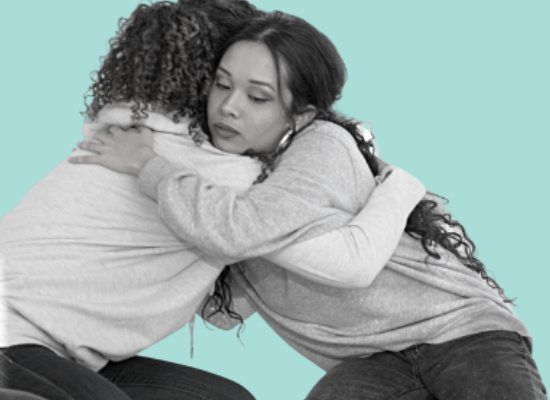
Stephanie Hepburn is a writer in New Orleans. She is the editor in chief of #CrisisTalk. You can reach her at .
Ebony Chambers worked in mental health for years before her daughter experienced her first suicide attempt, and suddenly the entire family was thrust into crisis. “People often forget that families with children in crisis are in crisis themselves,” she points out. Navigating the Sacramento behavioral health system, Chambers quickly found it plagued with chasms—ones that became glaringly obvious as she and her child had to overcome barrier after barrier. Even with a comprehensive web of knowledge and personal, professional support, she felt lost. “I recognized that if I felt this way,” she says, “it was likely quadrupled for people who face socioeconomic challenges or don’t have a support system that includes people in the field who can cut some of the red tape for them.” Chambers is the Chief Family and Youth Partnership Officer at Stanford Sierra Youth and Families.
Crisis care for children, notes Chambers, tends to only focus on the child. While that might sound intuitive, not incorporating a young person’s family puts the child back into a situation that was likely problematic. “You can’t address a child’s crisis without addressing family dynamics,” she says. “That’s not because parents or siblings don’t want the child to get better,” says Chambers, “but because we often don’t know what’s triggering them in the first place.” Furthermore, families need to know how best to support the child. When her daughter was hospitalized, staff interacted minimally with Chambers and her husband. “We kept saying, ‘Hey, we need support services too—we need the knowledge, skills, and resources to support her.’”
A discharge or treatment plan that fails to incorporate family dynamics will probably result in an environment that continues to harm the child. That’s precisely what happened when Chambers’ daughter returned home. She’s adopted and lost her biological father to suicide. “My husband was stepping into the massive shoes of a single father who had died,” says Chambers. “Unfortunately, his existence alone was triggering.” The couple was eager to improve the home environment for their child, but the clinical team didn’t involve them, so they weren’t aware of their daughter’s challenges. “Had we known and explored these difficulties as a family while she was hospitalized, it would have far better prepared us to support her.” However, no one would even return Chambers’ calls.
Inpatient psychiatric hospitalization provides acute, not long-term, stabilization. When 16-year-old Reina Chiang described her inpatient hospitalization experience in Maryland to #CrisisTalk, she highlighted that it wasn’t treatment-focused. “It’s a short-term bandaid,” she said. “They’re primarily making sure you don’t harm yourself, and that’s it.” Chambers says the short-term focus also results in a lack of family integration by clinical teams at acute care facilities. “We need to redefine what crisis stabilization looks like,” she says, “and that means ensuring family involvement and that long-term services are in place.” This is especially crucial because the weeks and months after a child or adolescent experiences psychiatric hospitalization are a vulnerable time. Matching young people to prompt care can reduce their risk of suicide. In fact, a study published in JAMA found that follow-up care within 7 days post hospitalization lessens the risk of suicide by 56% for children and adolescents. “So why are we discharging families and youth after they’ve experienced a crisis without a connection to a clinician who will provide ongoing support?”
While Chambers, her husband, and their daughter later addressed family dynamics through functional family therapy, an intervention program, she says the lack of family integration and long-term planning was a missed opportunity. “A stabilization team should brainstorm what issues they can solve at the moment,” she says, “but also lay out the resources and connections for the child and family so that they continue to receive support.” This is especially true for communities of color and other marginalized populations who face high barriers to care.
At the time of her child’s crisis, Chambers was already working at Stanford Sierra Youth and Families, but not in an advocacy role. Experiencing the crisis system with her daughter shifted her perspective and career trajectory. “I wanted to ensure that as families come in,” says Chambers, “we give them the resources and empowerment they need to navigate the system on behalf of their children.” Today, the organization provides comprehensive crisis services and a continuum of care to young people and their families. She points out it’s not only clinicians who children and families need after a crisis but also peer support for both. Trained youth peers at SSYF are typically in their early 20s. “They’ve navigated the mental health system and know what it’s like to be hospitalized,” says Chambers. Often, they’re also a bridge between the parent and child.
More unusual, though, is that the nonprofit matches families with peers. While navigating the crisis system, Chambers received parent peer support through her daughter’s mental health services. “I don’t know what I would’ve done without my peer,” she says. “They got me.” The crisis experience, she points out, is incredibly isolating. “It’s not watercooler talk,” she says. “If a colleague asked about my weekend, I wouldn’t say, ‘Oh, I worried all weekend about my daughter’s suicidal ideation.’” What Chambers needed was support from a parent who’d been where she was—someone who could walk alongside her and offer hope for recovery. “Someone else was coming in with letters and numbers behind their name, and that was great. They had the clinical expertise, but there’s nothing like someone sitting on the floor with you while you’re crying, and they understand what you’re going through.”
After the positive and profound effect parent peer support had on her, Chambers knew it was something she wanted to bring to Stanford Sierra Youth and Families. “Initially, it was just another parent and me,” she laughs. Today, the organization has 40 parent peers across five Northern California counties. While the Covid pandemic has had a disparate impact on people of color—from the virus itself and its economic effects, Chambers notes that shifting to virtual because of physical distancing mandates has also created an opportunity for her organization to reach more people. “It has opened a door for outreach and support,” she says, “allowing us to help people in our community and beyond.” For example, families from anywhere in the country can join their connection and support Zoom calls that support caregivers with a child who is LGBTQ+, experiencing mental health challenges, or on probation. The nonprofit also creates spaces for diverse caregivers, including single-parents, male caregivers, and grandparents.
Stanford Sierra Youth and Families serves about 5,913 youth and families, most of whom are on Medi-Cal, in the greater Northern California area. If a crisis arises after hours, families can call an on-call number from 5 pm to 9 am on weekdays and any time on weekends. The nonprofit also has a data system that maintains essential information, such as the family’s address and safety plan. If the clinician call taker can’t stabilize them by phone, the family will get an in-person response. One challenge, notes Chambers, is that SSYF services are unavailable for families through most commercial insurance plans, though the organization recently secured a contract with Kaiser Permanente. She hopes that other private insurers will soon follow suit. “We know what families get when they go through their private insurance isn’t sufficiently comprehensive,” she says.
With 988 around the corner, Chambers says state, regional, and community leaders need to be asking the populations they serve what they can do differently. “If we don’t value the voices of people who are affected,” she says, “we won’t be able to change these systems.” That means community involvement at every step of the way. Chambers references the saying “Nothing about us without us,” which means leaders shouldn’t make policies without representation and direct participation from those affected by them. “It also applies to the crisis system,” she says. “You can’t transform a system without full inclusion of those affected by that system. They’re the ones who know it best. They’re the experts of their lives and communities, and we have to hear and listen to their voices.”









